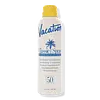What's inside
What's inside
 Key Ingredients
Key Ingredients

 Benefits
Benefits

 Concerns
Concerns

 Ingredients Side-by-side
Ingredients Side-by-side

Butyl Methoxydibenzoylmethane 2.9%
UV AbsorberHomosalate 8.8%
Skin ConditioningEthylhexyl Salicylate 4.9%
UV AbsorberOctocrylene 8.6%
UV AbsorberAcrylates/Octylacrylamide Copolymer
Alcohol Denat.
AntimicrobialAloe Barbadensis Leaf Extract
EmollientButyloctyl Salicylate
Skin ConditioningButyrospermum Parkii Oil
EmollientCarthamus Tinctorius Seed Oil
MaskingNelumbo Nucifera Extract
Skin ConditioningDiisopropyl Adipate
EmollientEthylhexyl Methoxycrylene
Skin ConditioningParfum
MaskingMusa Sapientum Fruit Extract
Skin ConditioningPolyester-8
Skin ConditioningTocopherol
AntioxidantButyl Methoxydibenzoylmethane 2.9%, Homosalate 8.8%, Ethylhexyl Salicylate 4.9%, Octocrylene 8.6%, Acrylates/Octylacrylamide Copolymer, Alcohol Denat., Aloe Barbadensis Leaf Extract, Butyloctyl Salicylate, Butyrospermum Parkii Oil, Carthamus Tinctorius Seed Oil, Nelumbo Nucifera Extract, Diisopropyl Adipate, Ethylhexyl Methoxycrylene, Parfum, Musa Sapientum Fruit Extract, Polyester-8, Tocopherol
Water
Skin ConditioningHomosalate
Skin ConditioningUndecane
EmollientTridecane
PerfumingDicaprylyl Carbonate
EmollientCoco-Caprylate/Caprate
EmollientDiethylamino Hydroxybenzoyl Hexyl Benzoate
UV FilterEthylhexyl Salicylate
UV AbsorberBis-Ethylhexyloxyphenol Methoxyphenyl Triazine
Skin ConditioningAcrylates/C12-22 Alkyl Methacrylate Copolymer
Ethylhexyl Triazone
UV AbsorberMethylene Bis-Benzotriazolyl Tetramethylbutylphenol
UV FilterDecyl Glucoside
CleansingXanthan Gum
EmulsifyingPolyurethane-34
Butylene Glycol
HumectantAcrylates/Beheneth-25 Methacrylate Copolymer
Silica
AbrasiveSqualane
EmollientTris-Biphenyl Triazine
UV AbsorberDisodium Phosphate
BufferingPhenoxyethanol
PreservativeEthylhexylglycerin
Skin ConditioningTocopheryl Acetate
AntioxidantUbiquinone
AntioxidantSodium Ascorbyl Phosphate
AntioxidantCaesalpinia Spinosa Fruit Pod Extract
Propylene Glycol
HumectantHelianthus Annuus Sprout Extract
Skin ConditioningSodium Benzoate
MaskingMelanin
Skin ProtectingWater, Homosalate, Undecane, Tridecane, Dicaprylyl Carbonate, Coco-Caprylate/Caprate, Diethylamino Hydroxybenzoyl Hexyl Benzoate, Ethylhexyl Salicylate, Bis-Ethylhexyloxyphenol Methoxyphenyl Triazine, Acrylates/C12-22 Alkyl Methacrylate Copolymer, Ethylhexyl Triazone, Methylene Bis-Benzotriazolyl Tetramethylbutylphenol, Decyl Glucoside, Xanthan Gum, Polyurethane-34, Butylene Glycol, Acrylates/Beheneth-25 Methacrylate Copolymer, Silica, Squalane, Tris-Biphenyl Triazine, Disodium Phosphate, Phenoxyethanol, Ethylhexylglycerin, Tocopheryl Acetate, Ubiquinone, Sodium Ascorbyl Phosphate, Caesalpinia Spinosa Fruit Pod Extract, Propylene Glycol, Helianthus Annuus Sprout Extract, Sodium Benzoate, Melanin
Ingredients Explained
These ingredients are found in both products.
Ingredients higher up in an ingredient list are typically present in a larger amount.
Ethylhexyl Salicylate is an organic compound used to block UV rays. It primarily absorbs UVB rays but offers a small amount of UVA protection as well.
Commonly found in sunscreens, Ethylhexyl Salicylate is created from salicylic acid and 2-ethylhexanol. You might know salicylic acid as the effective acne fighter ingredient and BHA.
The ethylhexanol in this ingredient is a fatty alcohol and helps hydrate your skin, similar to oils. It is an emollient, which means it traps moisture into the skin.
According to manufacturers, Ethylhexyl Salicylate absorbs UV wavelength of 295-315 nm, with a peak absorption at 307-310 nm. UVA rays are linked to long term skin damage, such as hyperpigmentation. UVB rays emit more energy and are capable of damaging our DNA. UVB rays cause sunburn.
Learn more about Ethylhexyl SalicylateHomosalate is a chemical sunscreen filter that provides protection in the UV-B range (280nm - 320 nm), with a peak protection at 306 nm. It is internationally approved for use in sunscreens.
Homosalate is not photo-stable, meaning it's strength as a UV filter degrades over time with exposure to the sun. Because of this, it's often used in combination with other chemical sunscreen filters as avobenzone (which protects from the UV-A range). Homosalate also helps act as a solvent for harder-to-dissolve UV filters.
(Part of the reason that sunscreens need to be frequently re-applied is due to the photo instability of many chemical sunscreen filters)
Currently, homosalate is approved in concentrations up to 10% in the EU and 15% in the US. The FDA is currently doing further research on the effects of homosalate, and it is possible that these approved concentrations will change in the future.
Learn more about Homosalate